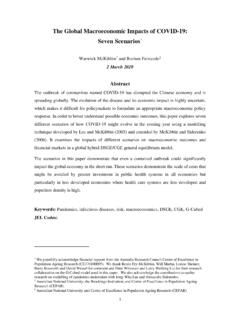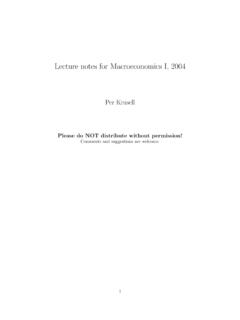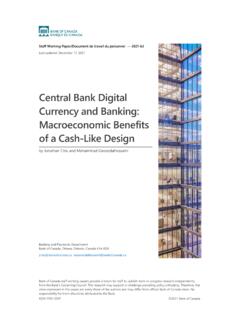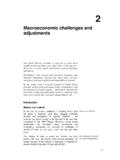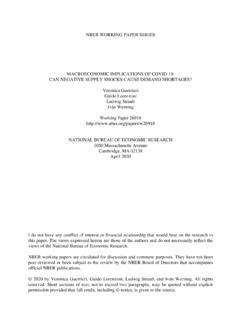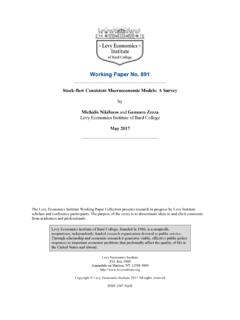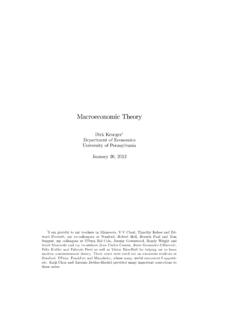Transcription of Fiscal policy, public debt and monetary policy in emerging ...
1 BIS Papers No 67 Fiscal policy , public debt and monetary policy in emerging market economies monetary and Economic Department October 2012 JEL classification: E52, E62, H63 Papers in this volume were prepared for a meeting of senior officials from central banks held at the Bank for International Settlements on 16 17 February 2012. The views expressed are those of the authors and do not necessarily reflect the views of the BIS or the central banks represented at the meeting. Individual papers (or excerpts thereof) may be reproduced or translated with the authorisation of the authors concerned. This publication is available on the BIS website ( ). Bank for International Settlements 2012. All rights reserved. Brief excerpts may be reproduced or translated provided the source is stated. ISSN 1609-0381 (print) ISBN 92-9131-152-9 (print) ISSN 1682 7651 (online) ISBN 92-9197-152-9 (online) BIS Papers No 67 iii Contents BIS background papers Fiscal policy , public debt and monetary policy in EMEs: an overview M S Mohanty.
2 1 Is monetary policy constrained by Fiscal policy ? Carlos Montoro, El d Tak ts and James Yetman .. 11 Developments of domestic government bond markets in EMEs and their implications Aaron Mehrotra, Ken Miyajima and Agust n Villar .. 31 Central bank and government debt management: issues for monetary policy Andrew Filardo, M S Mohanty and Ramon Moreno .. 51 Contributed papers Fiscal policy , public debt management and government bond markets: issues for central banks Miguel ngel Pesce .. 73 Fiscal consolidation and macroeconomic challenges in Brazil Carlos Hamilton Ara jo, Cyntia Azevedo and S lvio Costa .. 91 Macro policies and public debt in Chile Sebasti n Claro and Claudio Soto .. 103 monetary policy , Fiscal policy and public debt management People s Bank of China .. 113 Macroeconomic effects of structural Fiscal policy changes in Colombia Hernando Vargas, Andr s Gonz lez and Ignacio Lozano .. 119 Some insights into monetary and Fiscal policy interactions in the Czech Republic Vladim r Tom k.
3 161 The importance of Fiscal prudence under the Linked Exchange Rate System in Hong Kong SAR Hong Kong monetary Authority .. 173 The impact of public debt on foreign exchange reserves and central bank profitability: the case of Hungary Gergely Baksay, Ferenc Karvalits and Zsolt Kuti .. 179 Sovereign debt management in India: interaction with monetary policy R Gandhi .. 193 Fiscal policy , public debt management and government bond markets in Indonesia Mr Hendar .. 199 The interaction between monetary and Fiscal policy : insights from two business cycles in Israel Kobi Braude and Karnit Flug .. 205 public debt and monetary policy in Korea Geum Wha Oh .. 217 Banco de M xico and recent developments in domestic public debt markets Jos Sidaoui, Julio Santaella and Javier P rez .. 233 iv BIS Papers No 67 Fiscal policy considerations in the design of monetary policy in Peru Renzo Rossini, Zen n Quispe and Jorge Loyola.
4 253 Fiscal policy , public debt management and government bond markets: the case for the Philippines Diwa C Guinigundo .. 269 A framework for Fiscal vulnerability assessment and its application to Poland Tomasz J drzejowicz and Witold Kozi ski .. 285 Fiscal policy , public debt management and government bond markets: issues for central banks Elizaveta Danilova .. 295 Aspects of Fiscal / debt management and monetary policy interaction: the recent experience of Saudi Arabia Abdulrahman Al-Hamidy .. 301 Development of the government bond market and public debt management in Singapore monetary Authority of Singapore .. 309 Fiscal policy , public debt management and government bond markets: issues for central banks Lesetja Kganyago .. 315 Fiscal policy and its implication for central banks Suchada Kirakul .. 325 Globalisation of the interaction between Fiscal and monetary policy Mehmet Y r ko lu and Mustafa K l n.
5 335 List of participants .. 351 BIS Papers No 67 1 Fiscal policy , public debt and monetary policy in EMEs: an overview M S Mohanty1 1. Introduction During the 1980s and 1990s, the vulnerability of EMEs to shocks was often exacerbated by high Fiscal deficits, underdeveloped domestic bond markets, and large currency and maturity mismatches. In many cases Fiscal and monetary responses were procyclical. debt management policy played very little part in either the choice of an optimal debt maturity or in stabilising the economy. Since the beginning of 2000s, however, the role of Fiscal and monetary policy has started to become more active. Fiscal deficits and public debt levels in EMEs as a whole have declined substantially. Domestic financing has increased, and the share of foreign currency debt has fallen dramatically. And the average public debt maturity has lengthened significantly.
6 What do these developments mean for monetary policy , particularly in the context of the recent global financial crisis? Has the threat of Fiscal dominance in EMEs lessened, just when it has grown in the advanced economies (BIS (2012))? Have Fiscal and monetary policies in EMEs become more countercyclical than in the past? Has the development of domestic bond markets helped? What role have central banks played in debt management and what are the implications for monetary policy ? These questions were the focus of discussion at the 17th Annual Meeting of Deputy Governors from major EMEs held at the BIS in Basel on 16 17 February 2012. The meeting addressed three issues: (i) the Fiscal constraints on monetary policy ; (ii) the impact of local currency bond markets on central bank policies; and (iii) the role of central banks in public debt management.
7 The current volume brings together the papers prepared by the BIS staff for the meeting as well as the contributions of central One major finding emerging from the meeting was that improved Fiscal positions helped many EMEs to rely on countercyclical Fiscal and monetary policies to stabilise their economies during the recent global financial crisis. Anchoring medium-term Fiscal expectations was crucial, but it was not by itself sufficient to insulate the economy from the shock. Greater access to domestic financing and the consequent reduction of currency mismatches, enabled by the domestic currency bond market, played an important role. Yet these conclusions came with a number of caveats. Although Fiscal dominance has fallen in many EMEs, contingent liabilities and the costs of ageing populations pose serious medium- to long-term Fiscal risks to many EMEs.
8 In addition, although government debt levels have moderated, the volume of securities issued by central banks has expanded substantially, largely reflecting interventions in the foreign exchange market. Not only is the combined gross debt of the official sector (the government and the central bank) now large in many countries, but a considerable part of this debt consists of short-term securities, which are not characteristically very different from monetary financing. The implications of these balance sheet developments for price and financial stability require careful monitoring. 1 I am thankful to Ken Miyajima and El d Tak ts for their contributions to this overview, and to Philip Turner for comments. 2 The last time the Deputy Governors discussed Fiscal / monetary interaction was in 2002 (see BIS (2003)). 2 BIS Papers No 67 The rest of this overview summarises the key points from the discussion and the background papers along the three organising themes of the meeting.
9 2. Fiscal constraints on monetary policy For much of the past three decades, Fiscal policy remained a major concern for monetary policy in EMEs. Unsustainable Fiscal deficits and public debt levels created the spectre of Fiscal dominance in many countries, leading to high and volatile inflation and elevated risk premia on government debt . An unfavourable exchange rate dynamic linked to weak Fiscal and monetary policy credibility exposed EMEs to destabilising capital outflows. As summarized by Y r ko lu and Kilin in their paper, such a Fiscal setting was associated with low levels of financial development, a high degree of dollarisation, and high exchange rate pass-through. The consequence was that both Fiscal and monetary policies tended to be procyclical in many countries, accentuating rather than damping economic volatility.
10 Shift to countercyclical Fiscal and monetary policy However, as argued in this volume by Montoro, Tak ts and Yetman in their BIS background paper on Is monetary policy constrained by Fiscal policy ? , many EMEs have grown out of this procyclical policy bias over the past decade. A significant decline in Fiscal deficits and public debt has reduced the problem of Fiscal dominance, and made countercyclical policies more feasible. While EMEs average Fiscal deficits as a percentage of GDP fell through the 1990s and the 2000s, reaching during 2000 07, the period before the recent financial crisis, the reduction in gross public debt as a share of GDP was even more impressive. By measuring the degree of policy cyclicality from two separate Fiscal and monetary policy reaction functions (from a Taylor rule), the authors show that in a majority of EMEs both Fiscal and monetary policies were used to smooth output volatility during 2000 11.










